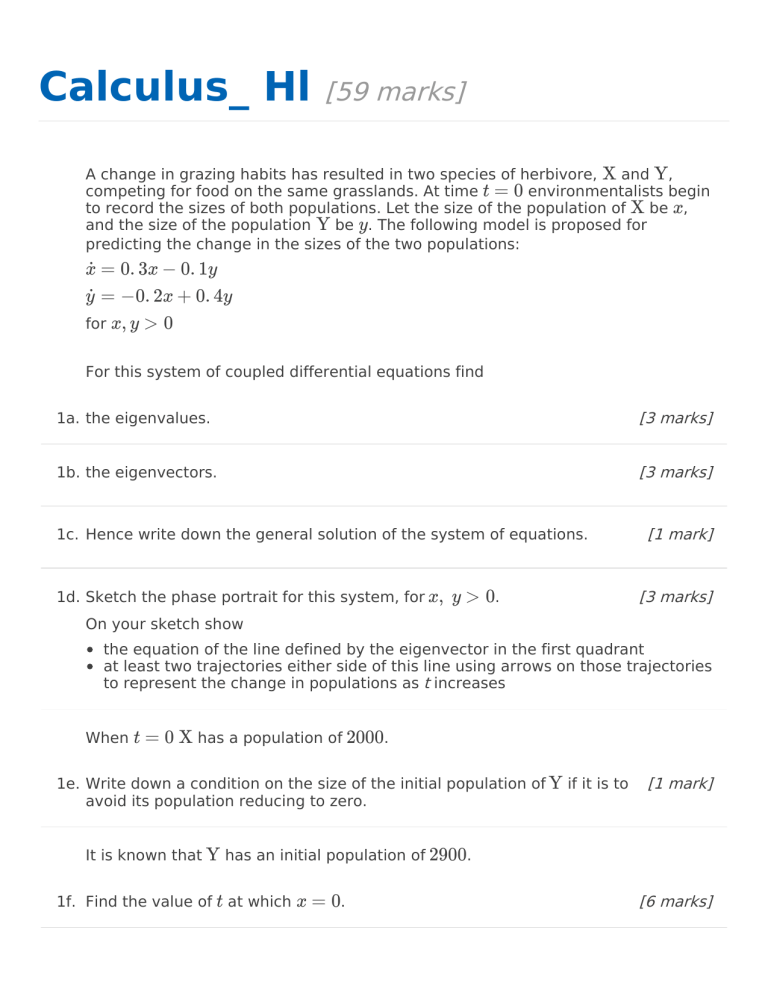Calculus Higher level IB MATH Application and Interpretation
advertisement

Calculus_ Hl [59 marks] A change in grazing habits has resulted in two species of herbivore, X and Y, competing for food on the same grasslands. At time t = 0 environmentalists begin to record the sizes of both populations. Let the size of the population of X be x, and the size of the population Y be y. The following model is proposed for predicting the change in the sizes of the two populations: ẋ = 0. 3x − 0. 1y ẏ = −0. 2x + 0. 4y for x, y > 0 For this system of coupled differential equations find 1a. the eigenvalues. [3 marks] 1b. the eigenvectors. [3 marks] 1c. Hence write down the general solution of the system of equations. 1d. Sketch the phase portrait for this system, for x, y > 0. [1 mark] [3 marks] On your sketch show the equation of the line defined by the eigenvector in the first quadrant at least two trajectories either side of this line using arrows on those trajectories to represent the change in populations as t increases When t = 0 X has a population of 2000. 1e. Write down a condition on the size of the initial population of Y if it is to avoid its population reducing to zero. [1 mark] It is known that Y has an initial population of 2900. 1f. Find the value of t at which Y x = 0. [6 marks] 1g. Find the population of Y at this value of t. Give your answer to the nearest 10 herbivores. [2 marks] Consider the system of paired differential equations ẋ = 3x + 2y ẏ = 2x + 3y. This represents the populations of two species of symbiotic toadstools in a large wood. Time t is measured in decades. 2a. Use the eigenvalue method to find the general solution to this system [10 marks] of equations. 2b. Given the initial conditions that when t particular solution. 2c. Hence find the solution when t = 0, x = 150, y = 50, find the = 1. [3 marks] [1 mark] 2d. As t → ∞, find an asymptote to the trajectory of the particular solution [4 marks] found in (b)(i) and state if this trajectory will be moving towards or away from the origin. Consider the following system of coupled differential equations. dx dt = −4x dy dt = 3x − 2y 3a. Find the eigenvalues and corresponding eigenvectors of the matrix ( −4 0 ). 3 −2 [6 marks] 3b. Hence, write down the general solution of the system. [2 marks] 3c. Determine, with justification, whether the equilibrium point (0, 0) is stable or unstable. [2 marks] d dy Find the value of d x 3d. (i) at (ii) at (4, 0). [3 marks] (−4, 0). 3e. Sketch a phase portrait for the general solution to the system of coupled [4 marks] differential equations for −6 ≤ x ≤ 6, −6 ≤ y ≤ 6. A point P moves in a straight line with velocity v ms−1 given by v (t) = e−t − 8t2 e−2t at time t seconds, where t ≥ 0. 4a. Determine the first time t1 at which P has zero velocity. [2 marks] 4b. Find an expression for the acceleration of P at time t. [2 marks] 4c. Find the value of the acceleration of P at time t1. [1 mark] © International Baccalaureate Organization 2023 International Baccalaureate® - Baccalauréat International® - Bachillerato Internacional® Printed for WOODSTOCK SCH 0912






